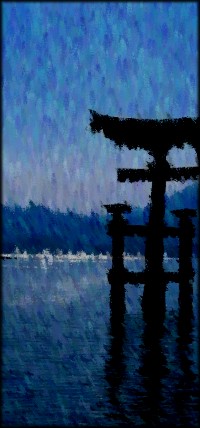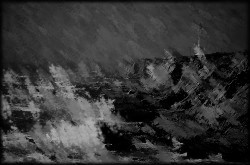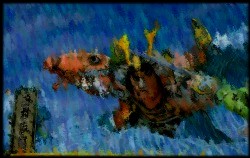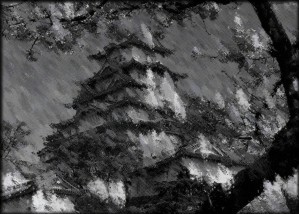 The
History of Kokubura
The
History of Kokubura
Hajime ni (The Beginning)
Not twenty centuries ago the Tourmaline Throne lie at the bottom of a vast ocean, unseen by any who breathed air and knew the sun.
With the birth of the goddess Iganari from a flask of the gods' sake, Kokubura was also raised from the depths of the sea, forming an island chain in a vast ocean where there was none before. Offended by the intrusion, Shei-wan, the Sea Dragon who Does not Sleep, threatened to sink the islands. Instead Iganari sacrificed herself, committing a ritual seppuku that bound the land to this world and satiated the dragon.
Iganari's islands were not void -- they were the land of spirits. The spirits, emboldened by their primogenitor's sacrifice, traveled the seas and land of Wei and brought to the island varied creatures, and in some cases, became like them.
The last creature who made Kokubura its home was human. Brought not by spirits but by their own sails and vision1, they laid on the land a rich nation that spread from north to south. In that nation poetry was as common as the sword, polite demeanor more important than martial strength.
During that time, the great spirit Marok devised a plan laid by fire gods to set the sky alight, both day and night. Marok gave them battle, eventually falling in what is now known as the Kainuik Wastelands, though not before arresting the fire spirits' intentions. Korobokuru shaman still pay homage to two grand mountains they claim to be Marok's chin and Marok's toe.
 Kokubura
no Kibo (Kokubura's Hope)
Kokubura
no Kibo (Kokubura's Hope)
But the spirits still dwelt in Kokubura.
And some of them fell, losing their original destiny to the fear of chaos and disorder. Tainted by their wider travels to anarchic realms, some had returned to Kokubura with creatures for the menagerie. Yet the sickness they displayed remained dormant until the very beings they had brought with them gained in number and power -- and called forth the latent forces within the spirits.
A great battle remembered as Kokubura no Kibo, the Hope of Kokubura, was fought in the Spirit Realm between those who remained true to the sacrifice of the goddess Iganari and those who had been corrupted. Though confined to the Spirit Realm, shamans of the humans and other races knew well enough that terrible changes were happening all about them.
Within a year after the war's inception, it poured out of the Spirit Realm into the Material. The human nation of Kokubura was put under siege by the fallen spirits and their charges. It was at this time a new race of humanoids, the vanara, were brought to Kokubura to secure the connection between some of the holier cedar forests and their counterparts in the Spirit Realm.
Of note, the ancient kingdom of Miusha was washed away in a tsunami called upon by the forces of law. The wave was so great it removed the mountains separating the Tai Pho and Shau Lai mountain ranges. In Miusha's place there now lies only a marshy wasteland.
 Invasion
Invasion
Hearing of the great rift between the Material and Spirit Realms, the Wu-Lai Emperor from across the sea sent a great fleet to assist the cause of law.
But before the fleet could reach the islands, the war ended, nobody the winner.
Finding the hostilities at an end, the great admiral decided instead to take Kokubura for the Wu-Lai Emperor, and landed in Makura and occupied the island. His next target was Marahiru, the capital of Kokubura. But as he sailed his fleet up the southern end of Takara ken, a great storm swept across the waters and sank Wu-Lai's ten thousand ships. Great geysers and whirlpools still haint those straits.
With the threat from the mainland dissipated and Kokubura no Kibo at a standstill, the nation of Kokubura finally had a chance to look in on itself... Whereas Kokubura once stretched from the Kainuik Wastelands to the southern tip of Makura, it now remained only in small pockets throughout the land.
Moreover, humanoid and monstrous kingdoms now stood at the very gates of Kokubura's recovering cities, and although weakened by the ravages of war themselves, these threats were nevertheless pertinent.
 Yoban
Senso (Barbarian War) and the Makuran Dragon
Yoban
Senso (Barbarian War) and the Makuran Dragon
During Kokubura no Kibo and subsequent invasion from the mainland, korobokuru barbarians had been treated as equals to humans, but after the threat had passed they were relegated to lower rank. They thus waged a second struggle, the Yoban Senso, with the human nation of Kokubura.
Soon afterward a great unknown menace to Kokubura arose. Seeking once again to part the rift between the Spirit Realm and the Material, a great dragon -- some say Shei-wan the Dragon Who Does not Sleep herself -- appeared over Makura, the site where Iganari's blood first spilt. Causing her to become mortal, a band called simply The Companions ventured to the Spirit Realm and fought a precarious battle in which only one of The Companions survived. The dragon lay defeated.
Though the divide between the Spirit and Material worlds was open only briefly, another race came forth, the nezumi, who now also inhabit Kokubura.
 Denouement
Denouement
The Companions last wandered this land nearly two hundred years ago. In that time the korobokuru have been pushed back beyond the Sheng mountains. Though that fight has tempered, barbarian tribes still stage reprisals, pouring out of the Kainuik Wastelands to harry and raid.
Threats to Kokubura do not sit idly, however. A cataclysmic eruption removed several impassible mountains in the Shau Lai range, revealing a sizeable and mysterious city called Kora. Inhabited not only by humans but other fanciful and even dreadful creatures, Kora remains separate from the nation. Some rumor that its is the offspring of ancient Miusha.
Of recent note, the first official emissary sent from the Tourmaline Throne returned from the mainland having not met the Emperor of Wei. The Emperor has apparently become of the missing. Additionally, the vanara who once felt only secure in their holy groves are re-initiating contact with human society once again.
Timeline
| Year | Event |
| The Year 1 began when the first emperor ascended the Tourmaline Throne. Dates before that have the marker mae, meaning "before." So for example, 127 mae means 127 years before Year 1. | |
| 700 mae | Iganari is born of the gods' sake Kokubura rises from the ocean. |
| 622 mae | Shei-wan, the Dragon Who Does not Sleep, petitions the Celestial Bureaucracy for "removal" of Kokubura. |
| 582 mae | Miusha is inhabited by spirits; later becomes a kingdom of chaos. |
| 498 mae | Shei-wan receives permission to sink the islands. |
| 497 mae | Iganari commits seppuku in protest of the gods' decision, spilling her blood on Kokubura and denying Shei-wan the means to sink them. |
| 450~50 mae | Spirits of Kokubura travel the realms and collect creatures to be its inhabitants. |
| 47 mae | The first humans arrive on Makura and are welcomed by spirit folk. |
| 32 mae | The great spirit Marok battles with gods who would light the sky afire. He is slain in but overthrows the fire spirits in the process. |
| 7 mae | Fu Xien discovers the Shrine of Iganari and drinks of the sake from which she was born. |
| 1 Kokubura | Fu Xien becomes Shinohara Tein, the first emperor of Kokubura, and establishes the capital at Marahiru. |
| 488? Kokubura | A ship carrying children seeking immortality for the Emperor of Wei land on the western coast of the main island. The helpful spirit that guided them there lays an enchantment to protect the area, keeping the survivors and their descendants safe from exploitation. The settlement becomes Kuro Tochi. |
| 680 Kokubura | Corrupted spirits wage war on Kokubura, beginning Kokubura no Kibo. |
| 681 Kokubura | The war spreads into the Material Realm, engaging almost every creature on the islands. |
| 932 Kokubura | Lawful spirits bring the vanara to Kokubura to strengthen the connection between certain holy cedar groves on the Material Realm and their counterparts on the Spirit Realm. This grants the lawful allies' ready access to the Spirit Realm. |
| 932 Kokubura | A tsunami washes away the anarchic kingdom of Miusha, leaving the Miusha Wastelands. |
| 934 Kokubura | The Wu-Lai Emperor of the Middle Kingdom on the mainland hears of the war and prepares a fleet of 10,000 ships to aid the cause. |
| 935 Kokubura | Kokubura no Kibo ends as chaotic and lawful powers alike fall back. |
| 936 Kokubura | Having launched the year before, Emperor Wu-Lai's feet arrives to find their purpose moot and the rift between Spirit and Material Realms once again whole. The admiral decides to take Kokubura for the Emperor. |
| 937 Kokubura | The island of Makura falls, but as the fleet moves toward Marahiru, it is sunk by a great wind. |
| 1020 ~ 1150 Kokubura |
Tired of serving the Tourmaline Throne for the little gratification they receive, korobokuru wage war on the human lands, beginning the Yoban Senso. The capital is moved from Marahiru to Nigashi. The korobokuru are finally pushed back into the Kainuik Wastelands. |
| 1083 Kokubura | The Companions defeat a great Dragon seeking to split the divide between Spirit and Material Realms. The nezumi are born of that conflict in the Spirit Realm. |
| 1180 Kokubura | A volcanic eruption and subsequent earthquakes remove several intervening mountains to reveal Kora, a mysterious and dark city in the Shau Lai mountains. |
| 1184 Kokubura | Mutera Nagashei initiates the connection of provincial capitals with arcane devices as the kingdom dissolves into isolated fiefdoms as a result of constant monster incursion. |
| 1260 Kokubura | Kora is noted to be an increasingly significant power, perhaps the spawn of the destroyed kingdom of Miusha. The first official emissaries sent from Kokubura since Kokubura no Kibo return from the mainland, reporting the Emperor of Wei disappeared. The vanara, who remain hidden in remote forests, become restless and encourage connections with human society. |
1 What, you thought they ate turkey?